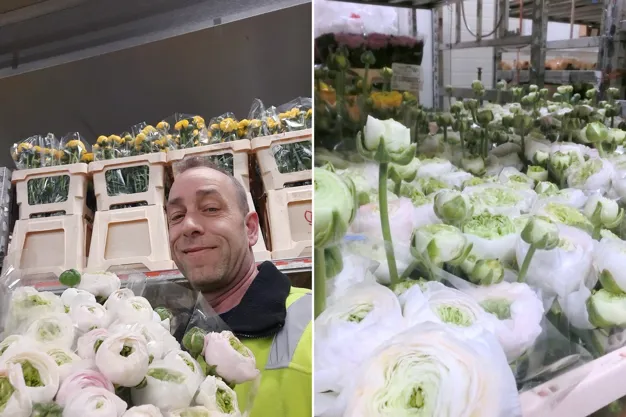In this edition of the auctioneer’s column, we turn our spotlight to the ranunculus, a cheerful and versatile flower that epitomizes spring. Auctioneer Paul Freriks shares insights and provides an update on the current state of the ranunculus market at the Royal FloraHolland auctions.
So far, the weather has been favorable for the ranunculus. The flower and plant thrive in sunlight but benefit from moderately warm spring weather. Once temperatures consistently exceed 17 degrees Celsius, the plant ceases to bloom. The flower buds then quickly become smaller and the stems lighter. Thanks to the relatively calm weather recently, the plants have been growing steadily, which has positively impacted their quality.

In the past two weeks (weeks 13 and 14), there has been a roughly 17% decrease in ranunculus supply at the auctions. As a result, prices were about 32% higher than last year. This year, there’s been a noticeable decrease in the supply of white, orange, and red ranunculus. Once again, orange ranunculus has been struggling in terms of price compared to other colors.
A True Seasonal Flower
The ranunculus is a beautiful seasonal flower that blooms in early spring. Originally from Central Asia (Afghanistan), the native population used the flower to decorate clothing and weapons. In the early 16th century, Spanish explorers introduced the ranunculus to Europe, where it quickly gained popularity. The flower was officially named Ranunculus, which is Latin for little frog, a nod to the wet environments where it naturally grows.
There are an astonishing 1,300 to 2,000 species of ranunculus worldwide. They are available in various colors and flower forms, including single and double-flowered, branched varieties, types with green grassy hearts, and ranunculus with full flowers characterized by their curled petals. The joyful flower is a wonderful symbol for those wishing to celebrate happiness, friendship, and love, and is often given as a gift for special occasions such as birthdays and anniversaries or to cheer someone up.
Ranunculus are supplied to the auction clocks from December to May from various countries. From December to April, the supply mainly comes from Italy and Israel, and from mid-March, the supply from the Netherlands begins. Depending on the weather, the Dutch supply usually lasts only 6 to 8 weeks, which is typical for a true seasonal flower.
Overview of the Total Auction Market in the Past 2 Weeks
The holidays this year are less favorably positioned. With Easter falling early, there’s a gap leading up to Mother’s Day (May 12) in terms of demand. Unfortunately, this was reflected in the prices of several products. However, we observed a diverse picture across different products. For instance, limonium and gypsophila saw a significant increase in quantities, which put some pressure on their prices. Products whose season has just started, such as cut hydrangeas and greenhouse peonies, on the other hand, were well-received and fetched good prices.
Even among plants, we’re ‘in-between’ holidays, causing prices to be somewhat pressured here and there. Bedding plants are fetching very good prices. Here too, the ranunculus serves as a welcome addition as a seasonal product. Especially violas and primulas, the harbingers of spring, were sky high! Green houseplants were reasonably priced, and flowering houseplants showed a mixed picture. Azaleas and hydrangeas were under some pressure, but begonias and exclusive blooming plants fetched good prices. As you can see, the season is in full swing. Follow the auction for more seasonal products!